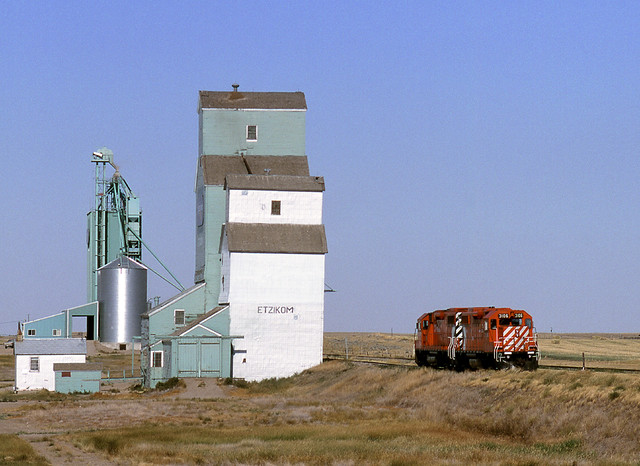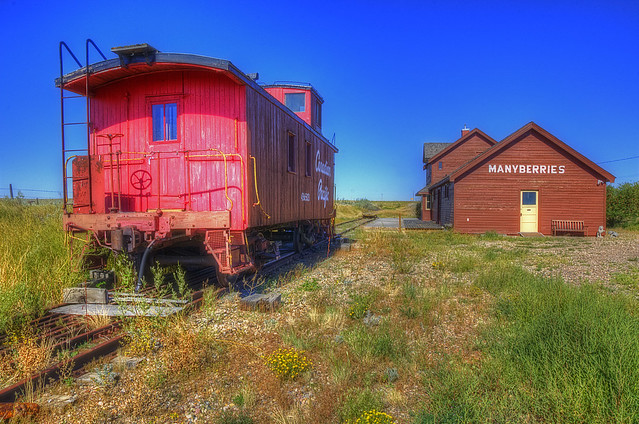Last fall, Jason Paul Sailer and I travelled along the former CP Stirling subdivision in Alberta. This subdivision had not seen a train in a long time and was up for abandonment. Since that time, the subdivision may be sold to the Forty Mile Rail Line group, who were expecting to begin operations on June 1, 2016. More on that below.
History of the Stirling Subdivision
 |
| CP Stirling subdivision timetable, 1938 |
The Stirling subdivision used to run between Lethbridge and Manyberries, as shown in the September 25, 1938 employee timetable entry to the right.
At some point the
CP Montana subdivision was defined to run between Lethbridge and Coutts / the US border, and the track from Stirling east became the CP Stirling subdivision.
In 2005 CP
listed a portion of the Stirling subdivision for abandonment from Foremost to Etzikom. That portion is now dismantled and the remainder of the Stirling subdivision (Foremost to Stirling) is listed on CP's 3 year plan. Presumably CP would keep a short spur to service the Pioneer elevator shown below.
Stirling
I picked Jason up in Lethbridge and we headed down to Stirling. The town of Stirling is on the
CP Montana subdivision and at one time was an important junction with the Stirling subdivision and the Cardston subdivision. Both of those subdivisions are now spurs up for abandonment.
There are no grain elevators in Stirling now, except for this cut-off elevator in a farmer's eclectic collection of storage structures. Check out those shipping containers!
 |
| A "convertible" grain elevator? |
Pioneer Grain Elevator
There is a large concrete Richardson Pioneer grain elevator just west of highway 4 on the Stirling spur. This massive 28,900 tonne structure was a UGG/Agricore structure when first constructed in 1998 and was originally 15,000 tonnes. The steel bins on each side were added around 2005 and it was acquired by Pioneer in 2008-2009.
The facility has four tracks - 2 for loading and 2 for storage - and can handle cars up to 268,000 lbs. each.
There was one hopper spotted at the elevator and two spotted at the east end of the tracks when we visited.
After photographing the elevator for a few minutes, we moved on.
Judson
At one time there were two grain elevators in Judson. The N. Bawlf grain elevator was built in 1917, and changed hands several times before closing in 1984. The Alberta Wheat Pool elevator was built in 1928, expanded with annexes twice, and closed in 1985.
There is nothing there now except a single house and a few bins.
Wrentham
There are two grain elevators in Wrentham, a former Alberta Wheat Pool elevator and a lovely old ex-Ogilvie Flour elevator. Until fairly recently there were three AWP elevators in Wrentham (
1999 photos)
Ogilvie Flour Elevator
The Ogilvie elevator is owned by the
Ogilvie Wooden Grain Elevator Society. This group, headed by Cody Kapcsos and Jason Paul Sailer, wishes to restore the elevator and maybe move it to the
Galt Historic Railway Park (
read more about the elevator and the society)
Since Jason had the keys, we could go in!
The office has the original tin walls. These are common in old grain elevator offices because the motor that drove the leg was located in the basement area of the office and the tin was there to protect against fire.
The office also has original shelving, some mysterious keys, and some old forms used by the elevator agent.
The original engine is pictured on the right. It powered the leg from here. I believe it is a gasoline engine. You can see the tin on the walls.
This elevator was built in 1925 with a capacity of 35,000 bushels. The balloon annex was added in 1950, and it was acquired by the Alberta Wheat Pool in 1958 as AWP #2 in Wrentham. In 1968 it was sold to a private farmer and the Society acquired it in 2014.
The elevator itself is a little dusty, as most elevators are.
The original chalk board is present, showing what was in each of the elevator's bins, along with the omnipresent warnings against fire in country grain elevators.
I was amused to see that the scale was built by the the Manitoba Bridge and Engineering Works Ltd. aka Dominion Bridge.
Once we finished the tour, we took a few more photos of the elevator and the overgrown rails.
Alberta Wheat Pool Elevator
The Alberta Wheat Pool elevator in Wrentham is the last remaining of the three that used to stand here. It was Alberta Wheat Pool #2. This was the largest; the other two stood between this one and the Ogilvie elevator.
The other two Alberta Wheat Pool grain elevators were:
- N. Bawlf Grain elevator, built 1917, became Alberta Pacific Grain in 1941, Federal Grain in 1967, Alberta Wheat Pool #3 in 1972, closed in 1999, demolished in 2000
- Alberta Wheat Pool elevator, built 1928, became Alberta Wheat Pool #1 in 1930, closed 1999, demolished in 2000
Conrad
There is nothing left at Conrad except for the old station sign and a few homes. (
bigdoer.com article /
Conrad station sign)
There were two Alberta Wheat Pool elevators here. #1 was built in 1934. I am not sure when they were demolished.
Skiff
 |
| Former Parrish and Heimbecker grain elevator in Skiff, Alberta |
The town of Skiff hosts a former Parrish and Heimbecker grain elevator. This elevator has a capacity of 4,060 tonnes and is apparently in use by a local owner. It was originally an Ellison Milling elevator built in 1929, acquired by Parrish and Heimbecker in 1975.
Skiff used to have two Alberta Wheat Pool grain elevators with a combined capacity of 7,340 tonnes but those were demolished around the year 2000 (Chris Stackhouse
image of all three). AWP #1 was built in 1929 with a capacity of 40,000 bushels and AWP #2 was built in 1954 with an 83,000 bushel capacity.
At one time CP stored a couple dozen cars at or near Skiff for preservation purposes. A few did go to worthy organizations such as the above mentioned
Galt Historic Railway Park, but most were scrapped on site in early 2011.
 |
| Public domain photo from Wikimedia, taken by Cody Kapcsos, I believe |
Eric Gagnon has
an extensive post on these Skiff cars.
I do love those yellow Parrish and Heimbecker elevators!
Kuehn Farms
 |
| Kuehn Farms grain elevator |
There is a private elevator located near Skiff at Kuehn Farms. I don't think it ever had rail access.
Legend
There were two grain elevators at Legend:
- Alberta Wheat Pool, built 1929, closed 1989. Its original capacity was 40,000 bushels.
- United Grain Growers, built 1936, closed 1998. The original elevator had a capacity of 30,000 bushels. The elevator's annex is located south of Nemiskam.
Foremost
 |
| The grain elevators of Foremost, Alberta |
The town of Foremost has an eclectic collection of elevators: a concrete Buffalo 2000 grain elevator, a former Agricore wooden elevator, and a diminutive private elevator.
Buffalo 2000
This large Buffalo 2000 elevator was built in 1983, but lasted in service for just less than 20 years before being closed and acquired by a local group. Note the loading apparatus in the photo above - it could apparently load two tracks at the same time. You can also see the remains of the Agricore logo on the side of the elevator.
I wrote extensively about
Buffalo grain elevators after Jason and I visited Magrath, AB.
Ex Agricore / Alberta Wheat Pool
 |
| Ex Agricore grain elevator in Foremost, Alberta |
Note that this elevator still has a full Agricore logo, over top of the Alberta Wheat Pool lettering. Also note the "NO. 2" above the driveway door, indicating this was not the only AWP elevator in Foremost at one time.
Until 1999-2000 there was a UGG grain elevator agglomeration in Foremost, with a capacity of 5,090 tonnes (
photo). I encourage you to check that link out as the UGG elevator apparently had an older, smaller one beside the main elevator as an annex.
Frankish Farms
 |
| Frankish Farms elevator in Foremost, AB |
The third elevator in Foremost is this interesting one owned by Frankish Farms Ltd. It looks like it is entirely clad in metal. This was originally a Lake of the Woods Milling elevator, built in 1925 with a capacity of 30,000 bushels.

Note that Foremost is the end of track for the CP Stirling subdivision at this time. The photo at right was taken at mile 0.14 facing west. The track continues just a bit east of highway 61 and ends with no ceremony.
Jason and I turned north on highway 61 so we didn't proceed any farther east.
There were several other stations past Foremost that no longer have any rail service. I will list each one below and share photos as I have found them.
Nemiscam
Nemiscam was mile 28.0 and in 1938 boasted a 59 car siding, like almost all sidings on the subdivision at that time.
Nemiscam/Nemiskam had a number of grain elevators over the years but none remain.
- Pioneer Grain, built 1915, closed 1925
- Western Canada Flour Mills, built 1915, closed 1925
- Alberta Pacific Grain, built 1915, became Federal Grain then UGG, closed 1988
- Victoria Elevator Company, built 1917, closed 1924
- UGG #1, built 1917, closed 1982
- Alberta Pool Elevators, built 1928, became Alberta Wheat Pool, expanded twice, closed 1997
Etzikom
The tiny hamlet of Etzikom is home to the
Canadian National Historic Windmill Centre, which apparently hosts dozens of windmills.
Etzikom has a steel grain elevator, built in 1988 and closed in 2001. This photo was taken by Jason Paul Sailer in 2015. The elevator is owned by a private farmer.
 |
| Etzikom grain elevator, by Jason Paul Sailer |
The below photo by Bill Hooper is from August 2000 and shows two CP GP38 locomotives parked at the former Alberta Wheat Pool elevator in Etzikom. They would leave the power there overnight and come back in the morning to run back to Stirling. I'd love to hear more about the shorter elevator!
 |
| Flickr photo by Bill Hooper |
Pakowki
Pakowki was mile 13.2 and in 1938 also had a 59 car siding.
Orion
Orion was at mile 6.6 of the Stirling subdivision in 1938. The town of Orion had two Alberta Wheat Pool grain elevators until near the end of the 20th century.
Manyberries
The town of Manyberries was the start of the CP Stirling subdivision in 1938. It was also mile 122.1 of the
CP Altawan subdivision that ran to Shaunavon. A portion of that subdivision still exists today, from Consul to Shaunavon, operated by the
Great Western Railway.
There are no grain elevators remaining in Manyberries but until recently it had an Alberta Wheat Pool grain elevator and a UGG grain elevator.
The old train station
exists in Manyberries, with a CP wooden caboose on display outside. (
Flickr photo)
 |
| Flickr photo of Manyberries station and caboose, by Terry Lawson |
The Future
This article talks about the 40 Mile Rail Group's interest to purchase the CP Stirling subdivision. It was published in mid March and aims to base its operations in Foremost, shipping grain and pulse crops to the CP main line at Stirling. The spokesperson, Len Mitzel, said they have more than 100 shareholders and were planning to start on June 1.
Given that we are nearing the end of April, it seems unlikely that the June 1 target will be achieved. The group seems to have gone "radio silent" so it's hard to know what is happening with the line. UPDATE:
They have opened!
Thanks to Jason for the tour of the line.
Check out his blog!
More from Alberta:



































